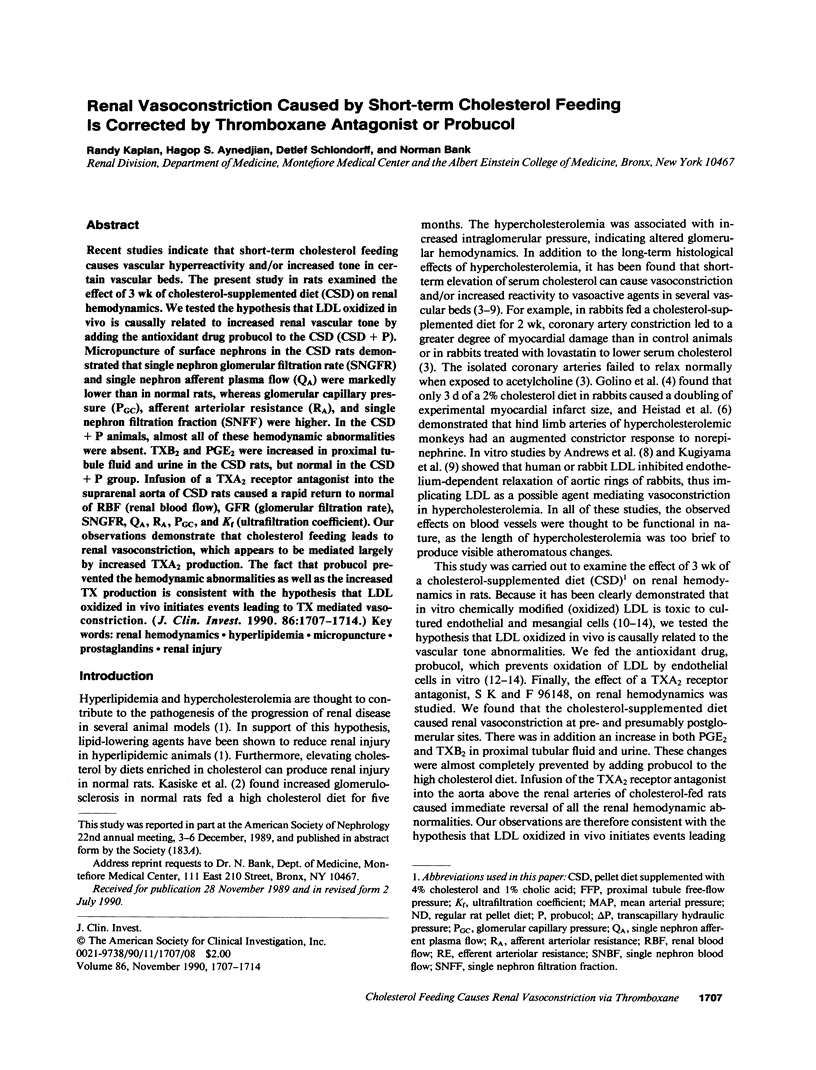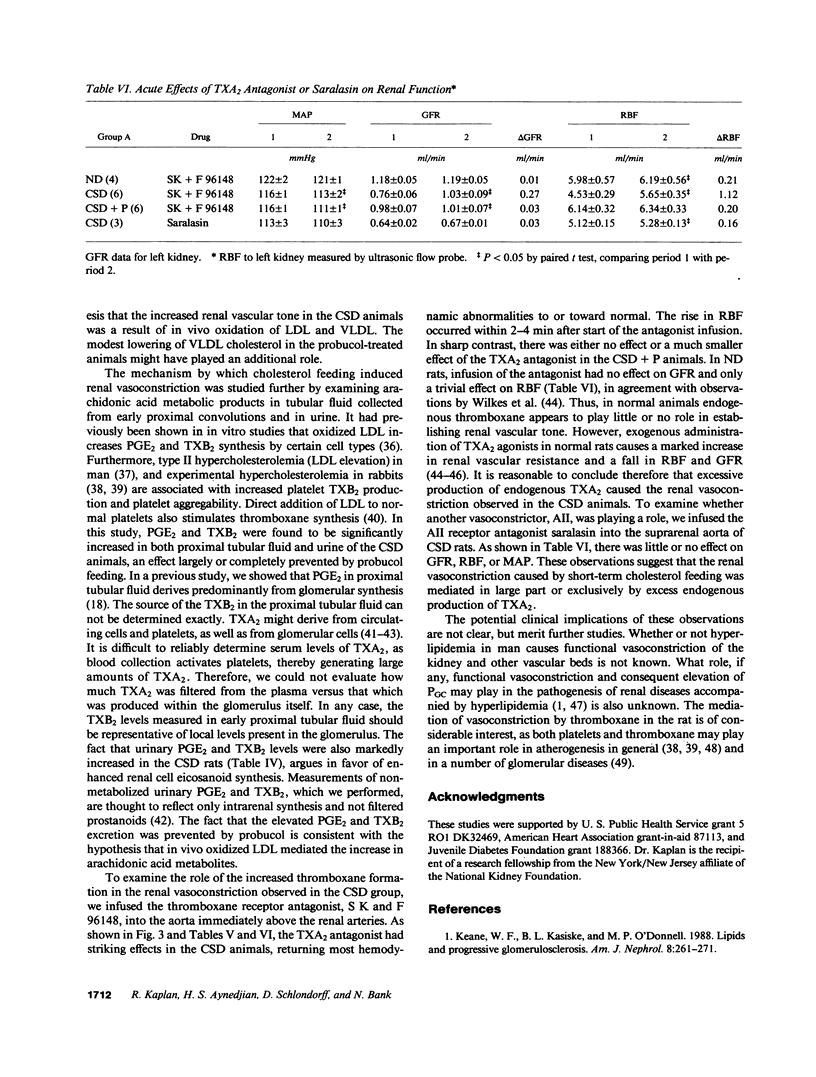Abstract
Recent studies indicate that short-term cholesterol feeding causes vascular hyperreactivity and/or increased tone in certain vascular beds. The present study in rats examined the effect of 3 wk of cholesterol-supplemented diet (CSD) on renal hemodynamics. We tested the hypothesis that LDL oxidized in vivo is causally related to increased renal vascular tone by adding the antioxidant drug probucol to the CSD (CSD + P). Micropuncture of surface nephrons in the CSD rats demonstrated that single nephron glomerular filtration rate (SNGFR) and single nephron afferent plasma flow (QA) were markedly lower than in normal rats, whereas glomerular capillary pressure (PGC), afferent arteriolar resistance (RA), and single nephron filtration fraction (SNFF) were higher. In the CSD + P animals, almost all of these hemodynamic abnormalities were absent. TXB2 and PGE2 were increased in proximal tubule fluid and urine in the CSD rats, but normal in the CSD + P group. Infusion of a TXA2 receptor antagonist into the suprarenal aorta of CSD rats caused a rapid return to normal of RBF (renal blood flow), GFR (glomerular filtration rate), SNGFR, QA, RA, PGC, and Kf (ultrafiltration coefficient). Our observations demonstrate that cholesterol feeding leads to renal vasoconstriction, which appears to be mediated largely by increased TXA2 production. The fact that probucol prevented the hemodynamic abnormalities as well as the increased TX production is consistent with the hypothesis that LDL oxidized in vivo initiates events leading to TX mediated vasoconstriction.
Full text
PDF







Selected References
These references are in PubMed. This may not be the complete list of references from this article.
- Allain C. C., Poon L. S., Chan C. S., Richmond W., Fu P. C. Enzymatic determination of total serum cholesterol. Clin Chem. 1974 Apr;20(4):470–475. [PubMed] [Google Scholar]
- Andrews H. E., Bruckdorfer K. R., Dunn R. C., Jacobs M. Low-density lipoproteins inhibit endothelium-dependent relaxation in rabbit aorta. Nature. 1987 May 21;327(6119):237–239. doi: 10.1038/327237a0. [DOI] [PubMed] [Google Scholar]
- Aoyagi T., Lowenstein L. M. The effect of bile acids and renal ischemia on renal function. J Lab Clin Med. 1968 Apr;71(4):686–692. [PubMed] [Google Scholar]
- Arbeeny C. M., Edelstein D., Freedman S. R., Eder H. A. Serum lipoproteins of diabetic rats fed a high cholesterol diet. Diabetes. 1980 Oct;29(10):774–777. doi: 10.2337/diacare.20.10.774. [DOI] [PubMed] [Google Scholar]
- Bank N., Coco M., Aynedjian H. S. Galactose feeding causes glomerular hyperperfusion: prevention by aldose reductase inhibition. Am J Physiol. 1989 Jun;256(6 Pt 2):F994–F999. doi: 10.1152/ajprenal.1989.256.6.F994. [DOI] [PubMed] [Google Scholar]
- Bank N., Lahorra G., Aynedjian H. S., Wilkes B. M. Sodium restriction corrects hyperfiltration of diabetes. Am J Physiol. 1988 May;254(5 Pt 2):F668–F676. doi: 10.1152/ajprenal.1988.254.5.F668. [DOI] [PubMed] [Google Scholar]
- Bank N., Mower P., Aynedjian H. S., Wilkes B. M., Silverman S. Sorbinil prevents glomerular hyperperfusion in diabetic rats. Am J Physiol. 1989 Jun;256(6 Pt 2):F1000–F1006. doi: 10.1152/ajprenal.1989.256.6.F1000. [DOI] [PubMed] [Google Scholar]
- Baylis C. Effects of administered thromboxanes on the intact, normal rat kidney. Ren Physiol. 1987;10(2):110–121. doi: 10.1159/000173120. [DOI] [PubMed] [Google Scholar]
- Beitz J., Panse M., Förster W. Low density lipoprotein (LDL) from male volunteers stimulated the thromboxane formation by human platelets. Prostaglandins Leukot Med. 1983 Apr;10(4):443–448. doi: 10.1016/0262-1746(83)90056-2. [DOI] [PubMed] [Google Scholar]
- Bird J. E., Milhoan K., Wilson C. B., Young S. G., Mundy C. A., Parthasarathy S., Blantz R. C. Ischemic acute renal failure and antioxidant therapy in the rat. The relation between glomerular and tubular dysfunction. J Clin Invest. 1988 May;81(5):1630–1638. doi: 10.1172/JCI113498. [DOI] [PMC free article] [PubMed] [Google Scholar]
- Bitterman H., Yanagisawa A., Lefer A. M. Beneficial actions of thromboxane receptor antagonism in hemorrhagic shock. Circ Shock. 1986;20(1):1–11. [PubMed] [Google Scholar]
- Bucolo G., David H. Quantitative determination of serum triglycerides by the use of enzymes. Clin Chem. 1973 May;19(5):476–482. [PubMed] [Google Scholar]
- Carvalho A. C., Colman R. W., Lees R. S. Platelet function in hyperlipoproteinemia. N Engl J Med. 1974 Feb 21;290(8):434–438. doi: 10.1056/NEJM197402212900805. [DOI] [PubMed] [Google Scholar]
- Chisolm G. M., 3rd, Morel D. W. Lipoprotein oxidation and cytotoxicity: effect of probucol on streptozotocin-treated rats. Am J Cardiol. 1988 Jul 25;62(3):20B–26B. doi: 10.1016/s0002-9149(88)80046-8. [DOI] [PubMed] [Google Scholar]
- Cirino M., Morton H., MacDonald C., Hadden J., Ford-Hutchinson A. W. Thromboxane A2 and prostaglandin endoperoxide analogue effects on porcine renal blood flow. Am J Physiol. 1990 Jan;258(1 Pt 2):F109–F114. doi: 10.1152/ajprenal.1990.258.1.F109. [DOI] [PubMed] [Google Scholar]
- Deen W. M., Robertson C. R., Brenner B. M. A model of glomerular ultrafiltration in the rat. Am J Physiol. 1972 Nov;223(5):1178–1183. doi: 10.1152/ajplegacy.1972.223.5.1178. [DOI] [PubMed] [Google Scholar]
- Diamond J. R., Karnovsky M. J. Exacerbation of chronic aminonucleoside nephrosis by dietary cholesterol supplementation. Kidney Int. 1987 Nov;32(5):671–677. doi: 10.1038/ki.1987.259. [DOI] [PubMed] [Google Scholar]
- Finestone H., Fechner C., Levy M. Effects of bile and bile salt infusions on renal function in dogs. Can J Physiol Pharmacol. 1984 Jul;62(7):762–768. doi: 10.1139/y84-125. [DOI] [PubMed] [Google Scholar]
- Golino P., Maroko P. R., Carew T. E. The effect of acute hypercholesterolemia on myocardial infarct size and the no-reflow phenomenon during coronary occlusion-reperfusion. Circulation. 1987 Jan;75(1):292–298. doi: 10.1161/01.cir.75.1.292. [DOI] [PubMed] [Google Scholar]
- Gryglewski R. J., Dembińska-Kiè A., Zmuda A., Gryglewska T. Prostacyclin and thromboxane A2 biosynthesis capacities of heart, arteries and platelets at various stages of experimental atherosclerosis in rabbits. Atherosclerosis. 1978 Dec;31(4):385–394. doi: 10.1016/0021-9150(78)90133-8. [DOI] [PubMed] [Google Scholar]
- Heistad D. D., Armstrong M. L., Marcus M. L., Piegors D. J., Mark A. L. Augmented responses to vasoconstrictor stimuli in hypercholesterolemic and atherosclerotic monkeys. Circ Res. 1984 Jun;54(6):711–718. doi: 10.1161/01.res.54.6.711. [DOI] [PubMed] [Google Scholar]
- Henriksen T., Evensen S. A., Carlander B. Injury to human endothelial cells in culture induced by low density lipoproteins. Scand J Clin Lab Invest. 1979 Jun;39(4):361–368. doi: 10.3109/00365517909106120. [DOI] [PubMed] [Google Scholar]
- Henriksen T., Mahoney E. M., Steinberg D. Enhanced macrophage degradation of low density lipoprotein previously incubated with cultured endothelial cells: recognition by receptors for acetylated low density lipoproteins. Proc Natl Acad Sci U S A. 1981 Oct;78(10):6499–6503. doi: 10.1073/pnas.78.10.6499. [DOI] [PMC free article] [PubMed] [Google Scholar]
- Hessler J. R., Robertson A. L., Jr, Chisolm G. M., 3rd LDL-induced cytotoxicity and its inhibition by HDL in human vascular smooth muscle and endothelial cells in culture. Atherosclerosis. 1979 Mar;32(3):213–229. doi: 10.1016/0021-9150(79)90166-7. [DOI] [PubMed] [Google Scholar]
- Kasiske B. L., O'Donnell M. P., Schmitz P. G., Kim Y., Keane W. F. Renal injury of diet-induced hypercholesterolemia in rats. Kidney Int. 1990 Mar;37(3):880–891. doi: 10.1038/ki.1990.62. [DOI] [PubMed] [Google Scholar]
- Keane W. F., Kasiske B. L., O'Donnell M. P. Lipids and progressive glomerulosclerosis. A model analogous to atherosclerosis. Am J Nephrol. 1988;8(4):261–271. doi: 10.1159/000167599. [DOI] [PubMed] [Google Scholar]
- Kita T., Nagano Y., Yokode M., Ishii K., Kume N., Narumiya S., Kawai C. Prevention of atherosclerotic progression in Watanabe rabbits by probucol. Am J Cardiol. 1988 Jul 25;62(3):13B–19B. doi: 10.1016/s0002-9149(88)80045-6. [DOI] [PubMed] [Google Scholar]
- Lianos E. A. Eicosanoids and the modulation of glomerular immune injury. Kidney Int. 1989 Apr;35(4):985–992. doi: 10.1038/ki.1989.82. [DOI] [PubMed] [Google Scholar]
- Osborne J. A., Lento P. H., Siegfried M. R., Stahl G. L., Fusman B., Lefer A. M. Cardiovascular effects of acute hypercholesterolemia in rabbits. Reversal with lovastatin treatment. J Clin Invest. 1989 Feb;83(2):465–473. doi: 10.1172/JCI113905. [DOI] [PMC free article] [PubMed] [Google Scholar]
- Parthasarathy S., Steinbrecher U. P., Barnett J., Witztum J. L., Steinberg D. Essential role of phospholipase A2 activity in endothelial cell-induced modification of low density lipoprotein. Proc Natl Acad Sci U S A. 1985 May;82(9):3000–3004. doi: 10.1073/pnas.82.9.3000. [DOI] [PMC free article] [PubMed] [Google Scholar]
- Parthasarathy S., Young S. G., Witztum J. L., Pittman R. C., Steinberg D. Probucol inhibits oxidative modification of low density lipoprotein. J Clin Invest. 1986 Feb;77(2):641–644. doi: 10.1172/JCI112349. [DOI] [PMC free article] [PubMed] [Google Scholar]
- Petrulis A. S., Aikawa M., Dunn M. J. Prostaglandin and thromboxane synthesis by rat glomerular epithelial cells. Kidney Int. 1981 Oct;20(4):469–474. doi: 10.1038/ki.1981.163. [DOI] [PubMed] [Google Scholar]
- Pradelles P., Grassi J., Maclouf J. Enzyme immunoassays of eicosanoids using acetylcholine esterase as label: an alternative to radioimmunoassay. Anal Chem. 1985 Jun;57(7):1170–1173. doi: 10.1021/ac00284a003. [DOI] [PubMed] [Google Scholar]
- Scharschmidt L. A., Lianos E., Dunn M. J. Arachidonate metabolites and the control of glomerular function. Fed Proc. 1983 Nov;42(14):3058–3063. [PubMed] [Google Scholar]
- Schlondorff D., Ardaillou R. Prostaglandins and other arachidonic acid metabolites in the kidney. Kidney Int. 1986 Jan;29(1):108–119. doi: 10.1038/ki.1986.13. [DOI] [PubMed] [Google Scholar]
- Schlondorff D., Aynedjian H. S., Satriano J. A., Bank N. In vivo demonstration of glomerular PGE2 responses to physiological manipulations and experimental agents. Am J Physiol. 1987 Apr;252(4 Pt 2):F717–F723. doi: 10.1152/ajprenal.1987.252.4.F717. [DOI] [PubMed] [Google Scholar]
- Shimokawa H., Tomoike H., Nabeyama S., Yamamoto H., Araki H., Nakamura M., Ishii Y., Tanaka K. Coronary artery spasm induced in atherosclerotic miniature swine. Science. 1983 Aug 5;221(4610):560–562. doi: 10.1126/science.6408736. [DOI] [PubMed] [Google Scholar]
- Smith E. F., 3rd, McDonald J. Protective effects of the thromboxane receptor antagonists BM 13.177 and BM 13.505 against U 46619-induced sudden death in rats. Pharmacology. 1988;36(5):340–347. doi: 10.1159/000138404. [DOI] [PubMed] [Google Scholar]
- Steinberg D., Parthasarathy S., Carew T. E., Khoo J. C., Witztum J. L. Beyond cholesterol. Modifications of low-density lipoprotein that increase its atherogenicity. N Engl J Med. 1989 Apr 6;320(14):915–924. doi: 10.1056/NEJM198904063201407. [DOI] [PubMed] [Google Scholar]
- Steinbrecher U. P., Parthasarathy S., Leake D. S., Witztum J. L., Steinberg D. Modification of low density lipoprotein by endothelial cells involves lipid peroxidation and degradation of low density lipoprotein phospholipids. Proc Natl Acad Sci U S A. 1984 Jun;81(12):3883–3887. doi: 10.1073/pnas.81.12.3883. [DOI] [PMC free article] [PubMed] [Google Scholar]
- Verbeuren T. J., Jordaens F. H., Zonnekeyn L. L., Van Hove C. E., Coene M. C., Herman A. G. Effect of hypercholesterolemia on vascular reactivity in the rabbit. I. Endothelium-dependent and endothelium-independent contractions and relaxations in isolated arteries of control and hypercholesterolemic rabbits. Circ Res. 1986 Apr;58(4):552–564. doi: 10.1161/01.res.58.4.552. [DOI] [PubMed] [Google Scholar]
- Wasserman J., Santiago A., Rifici V., Holthofer H., Scharschmidt L., Epstein M., Schlondorff D. Interactions of low density lipoprotein with rat mesangial cells. Kidney Int. 1989 May;35(5):1168–1174. doi: 10.1038/ki.1989.106. [DOI] [PubMed] [Google Scholar]
- Watanabe J., Wohltmann H. J., Klein R. L., Colwell J. A., Lopes-Virella M. F. Enhancement of platelet aggregation by low-density lipoproteins from IDDM patients. Diabetes. 1988 Dec;37(12):1652–1657. doi: 10.2337/diab.37.12.1652. [DOI] [PubMed] [Google Scholar]
- Yokoyama M., Akita H., Mizutani T., Fukuzaki H., Watanabe Y. Hyperreactivity of coronary arterial smooth muscles in response to ergonovine from rabbits with hereditary hyperlipidemia. Circ Res. 1983 Jul;53(1):63–71. doi: 10.1161/01.res.53.1.63. [DOI] [PubMed] [Google Scholar]
- Zmuda A., Dembinska-Kiec A., Chytkowski A., Gryglewski R. J. Experimental atherosclerosis in rabbits: platelet aggregation, thromboxane A2 generation and anti-aggregatory potency of prostacyclin. Prostaglandins. 1977;14(6):1035–1042. doi: 10.1016/0090-6980(77)90283-0. [DOI] [PubMed] [Google Scholar]
- van Hinsbergh V. W., Scheffer M., Havekes L., Kempen H. J. Role of endothelial cells and their products in the modification of low-density lipoproteins. Biochim Biophys Acta. 1986 Aug 14;878(1):49–64. doi: 10.1016/0005-2760(86)90343-7. [DOI] [PubMed] [Google Scholar]


